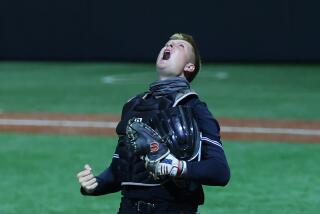Such Is the Stuff of Dreams . . . : Baseball Hopefuls Given Their Chance
- Share via
SAN DIEGO — ‘We’re here to find ballplayers with the tools to be professionals. We’re not here for a walk in the park.’
--Rick Magante
The first cars began pulling into the parking lot about 8 o’clock Saturday morning for a major league baseball tryout camp at Southwestern College in Chula Vista.
The grass was still wet with dew, the bullpen mounds were muddy and a gloomy blanket of clouds hung overhead.
It was early, but not too early for dreams.
From as far away as Washington, Oregon and Wyoming, ballplayers in their teens and early 20s had come to test their dreams against the stopwatches, fungo bats and critical eyes of big league scouts.
There were 166 hopefuls: 48 pitchers, 53 outfielders, 14 third basemen, 14 catchers, 12 first basemen, 15 second basemen and 10 shortstops.
Accompanied by parents, girlfriends and well-wishers, the ballplayers seemed nervous and subdued.
They were an eclectic group in terms of fashion--shorts to jeans to running tights to pinstriped uniforms.
Their gear ranged from battered fielder’s gloves to well-stocked equipment bags with several pairs of shoes and shiny aluminum bats. There was so much stuff that no one would have noticed if someone had opened a black box and pulled out a bat inscribed “Wonderboy.”
The group included a high school junior who expects to be drafted next year and several minor league veterans who had been cut and were hoping for another fling, plus a sportswriter out to do a George Plimpton-style participation article.
Lee Lanzarotta, directing the tryout camp for the big league scouting bureau, was pulling for all of them.
He, too, believes in The Dream.
“There are some big leaguers who were discovered in camps like this,” he said. “Keith Hernandez of the New York Mets is one who comes to mind.
“Sure, the odds are greatly against most of these kids. We might spend 10 hours on the field without seeing a prospect. But we found a kid last year who had been a terrible college shortstop and when he tried out as a pitcher, he threw in the 90s and signed a minor league contract.”
Lanzarotta also cited the example of an outfielder he saw a few years back. The player didn’t quite have the tools, but he did have tenacity.
After attending several tryout camps, he was signed by a scout and sent to a minor league team in Elmira, N.Y. There he was briefly a teammate of future Boston star Bruce Hurst. A collision with an outfield fence resulted in a rib injury that ended his career.
The atmosphere of Saturday’s session--one of 50 conducted annually by the big league scouting bureau--was quickly established by Rick Magante, one of Lanzarotta’s cohorts.
The mood would be pleasant but impersonal, Magante said as players filled out registration forms and were assigned a number.
“We don’t have the luxury of referring to you by your name, so please be attentive and remember your number,” Magante said.
“We’re here to find ballplayers with the tools to be professionals. We’re not here for a walk in the park. We will be candid and objective with you.”
Translated, that meant that a pitcher might get to throw 10 balls down in the bullpen and if he didn’t show a live arm, well, scratch one career. More than one disappointed pitcher donned his warmup jacket and shuffled off, head down and flanked by parents, toward the parking lot.
Lanzarotta, who has been scouting for 10 years, scrutinized the pitchers while the position players were clocked in the 60-yard dash, then evaluated for arm strength and fielding ability. Later, the most promising players would be invited to participate in a game for the benefit of scouts. If there were any prospects, they would be contacted later by interested teams.
Lanzarotta travels with a briefcase, but it isn’t your standard businessman’s case. Inside, packed in Styrofoam, is one of those speed guns, such as the Highway Patrol uses to catch speeders.
Taking a seat in a folding lawn chair set up behind a protective screen, Lanzarotta plugged the speed gun into a battery pack and reached for his clipboard.
There were two pitchers working simultaneously, but it was easy for the veteran scout to chart each of them. He really doesn’t need the speed gun to spot a prospect.
“When a kid’s fastball really explodes, you don’t guess, you know,” Lanzarotta said. “I saw a kid a few weeks ago in Brawley who was throwing in the 90s. Cleveland signed him. You see a kid throwing 92, 93 miles an hour, even if it’s going straight, you like him. You can teach him how to cut the ball (to get movement).”
A major league prospect needs an 85-m.p.h. fastball. Scouts will go a bit lower, to 81 or 82, if the ball moves and the pitcher has control.
One player who caught Lanzarotta’s eye was Willie Navarrette, a high school junior from Riverside who has attended several camps in the past two years.
Navarrette is overweight at 210 pounds and has been told by scouts that he needs to shed 15 pounds. But he also has been told that he could be drafted next spring, so he is pushing himself away from the table and thinking only of pitching.
“I’m a little nervous,” he said, “but I’ve been in these situations and I know what to expect. I’ve seen a couple of fastballs today that were faster than mine, but they didn’t have the movement or the location. I think I’m as good as anybody here.”
But he does have a few things to learn. Sartorially, his coordination can improve. Navarrette was wearing a Cleveland Indians uniform with a Minnesota Twins cap. And his well-worn left shoe consisted of several flaps of leather and a few holes.
While the pitchers were exhibiting their stuff, the outfielders were shagging flies and throwing the ball in to the catcher with varying degrees of efficiency.
One lanky fielder sprinted under the ball and snapped off a throw that bounced smartly to the plate on one hop. Moments later, a stocky fellow in shorts heaved the ball up the third-base line and into a dugout full of infielders waiting their turn.
“It slipped,” the player said with a mixture of guilt and embarrassment.
The scout picked up his bullhorn and called for the next suspect.
When the time comes to dismiss a player, the scouts try to be polite. Ending someone’s dream is never easy, even when you’ve had to end thousands of them.
“You try to be as nice as you can,” Lanzarotta said, “but sometimes you have to be, uh, blunt. Some kids take rejection as a matter of course. Others get mad and call you colorful names.
“I’ve never been threatened, and I hope it wouldn’t ever come to that. Some guys can be pretty persistent. ‘But I know I can pitch in the big leagues,’ a player will say. Yeah, right, but there’s a big difference in knowing and doing.”
Martin Henderson, a writer for a San Diego suburban paper, knows. He was trying out as a knuckleball pitcher, part-Plimpton, part-Niekro, and was having his difficulties.
“Hey, I was prepared to sign up and get on the next bus to Modesto,” Henderson told a TV interviewer. “Everybody dreams of being a big leaguer. This was my last chance.”
More to Read
Go beyond the scoreboard
Get the latest on L.A.'s teams in the daily Sports Report newsletter.
You may occasionally receive promotional content from the Los Angeles Times.










